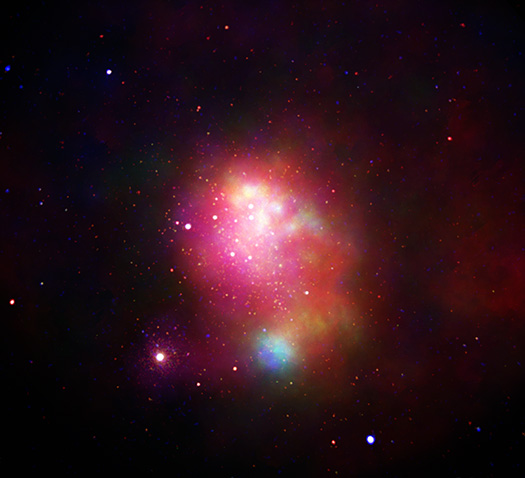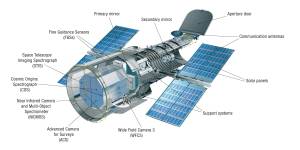
The Chandra spacecraft and its components. NASA/CXC/SAO & J.Vaughan
From The National Aeronautics and Space Administration Chandra X-ray telescope
6.4.24
Megan Watzke
mwatzke@cfa.harvard.edu
Chandra X-ray Center
Cambridge, Mass.
617-496-7998
Jonathan Deal
jonathan.e.deal@nasa.gov
Marshall Space Flight Center
Huntsville, Ala.
256-544-0034

Composite

X-ray

Optical
Westerlund 1 is the biggest and closest “super” star cluster to Earth. New data from NASA’s Chandra X-ray Observatory, in combination with other NASA telescopes, is helping astronomers delve deeper into this galactic factory where stars are vigorously being produced.
_________________________________
A new image of Westerlund 1, the biggest and closest “super” star cluster to Earth, with deep Chandra data is being released.
Westerlund 1 is a dense site in the Milky Way galaxy where young massive stars have formed at a prodigious rate.
By studying this cluster in X-rays, astronomers can learn more about how our galaxy produced stars earlier in its history.
This new image contains 12 days’ worth of Chandra observing time, which has been combined with optical data from Hubble.
_________________________________
This is the first data to be publicly released from a project called the Extended Westerlund 1 and 2 Open Clusters Survey, or EWOCS, led by astronomers from the Italian National Institute of Astrophysics in Palermo. As part of EWOCS, Chandra observed Westerlund 1 for about 12 days in total.
Currently, only a handful of stars form in our galaxy each year, but in the past the situation was different. The Milky Way used to produce many more stars, likely hitting its peak of churning out dozens or hundreds of stars per year about 10 billion years ago and then gradually declining ever since. Astronomers think that most of this star formation took place in massive clusters of stars, known as “super star clusters,” like Westerlund 1. These are young clusters of stars that contain more than 10,000 times the mass of the Sun. Westerlund 1 is between about 3 million and 5 million years old.
This new image shows the new deep Chandra data along with previously released data from NASA’s Hubble Space Telescope.

The X-rays detected by Chandra show young stars (mostly represented as white and pink) as well as diffuse heated gas throughout the cluster (colored pink, green, and blue, in order of increasing temperatures for the gas). Many of the stars picked up by Hubble appear as yellow and blue dots.
Only a few super star clusters still exist in our galaxy, but they offer important clues about this earlier era when most of our galaxy’s stars formed. Westerlund 1 is the biggest of these remaining super star clusters in the Milky Way and contains a mass between 50,000 and 100,000 Suns. It is also the closest super star cluster to Earth at about 13,000 light-years.
These qualities make Westerlund 1 an excellent target for studying the impact of a super star cluster’s environment on the formation process of stars and planets as well as the evolution of stars over a broad range of masses.
This new deep Chandra dataset of Westerlund 1 has more than tripled the number of X-ray sources known in the cluster. Before the EWOCS project, Chandra had detected 1,721 sources in Westerlund 1. The EWOCS data found almost 6,000 X-ray sources, including fainter stars with lower masses than the Sun. This gives astronomers a new population to study.
One revelation is that 1,075 stars detected by Chandra are squeezed into the middle of Westerlund 1 within four light-years of the cluster’s center. For a sense of how crowded this is, four light-years is about the distance between the Sun and the next closest star to Earth.
The diffuse emission seen in the EWOCS data represents the first detection of a halo of hot gas surrounding the center of Westerlund 1, which astronomers think will be crucial in assessing the cluster’s formation and evolution, and giving a more precise estimate of its mass.
A paper published in the journal Astronomy and Astrophysics, led by Mario Guarcello from the Italian National Institute of Astrophysics in Palermo, discusses the survey and the first results. Follow-up papers will discuss more about the results, including detailed studies of the brightest X-ray sources. This future work will analyze other EWOCS observations, involving NASA’s James Webb Space Telescope and NICER (Neutron Star Interior Composition Explorer).


See the full article here .
Comments are invited and will be appreciated, especially if the reader finds any errors which I can correct.

five-ways-keep-your-child-safe-school-shootings
Please help promote STEM in your local schools.
NASA’s Marshall Space Flight Center in Huntsville, Ala., manages the Chandra program for NASA’s Science Mission Directorate in Washington. The Smithsonian Astrophysical Observatory controls Chandra’s science and flight operations from Cambridge, Mass.
In 1976 the Chandra X-ray Observatory (called AXAF at the time) was proposed to National Aeronautics and Space Administration by Riccardo Giacconi and Harvey Tananbaum. Preliminary work began the following year at NASA’s Marshall Space Flight Center and the Harvard Smithsonian Center for Astrophysics. In the meantime, in 1978, NASA launched the first imaging X-ray telescope, Einstein (HEAO-2), into orbit. Work continued on the AXAF project throughout the 1980s and 1990s. In 1992, to reduce costs, the spacecraft was redesigned. Four of the twelve planned mirrors were eliminated, as were two of the six scientific instruments. AXAF’s planned orbit was changed to an elliptical one, reaching one third of the way to the Moon’s at its farthest point. This eliminated the possibility of improvement or repair by the space shuttle but put the observatory above the Earth’s radiation belts for most of its orbit. AXAF was assembled and tested by TRW (now Northrop Grumman Aerospace Systems) in Redondo Beach, California.
AXAF was renamed Chandra as part of a contest held by NASA in 1998, which drew more than 6,000 submissions worldwide. The contest winners, Jatila van der Veen and Tyrel Johnson (then a high school teacher and high school student, respectively), suggested the name in honor of Nobel Prize–winning Indian-American astrophysicist Subrahmanyan Chandrasekhar. He is known for his work in determining the maximum mass of white dwarf stars, leading to greater understanding of high energy astronomical phenomena such as neutron stars and black holes. Fittingly, the name Chandra means “moon” in Sanskrit.
Originally scheduled to be launched in December 1998, the spacecraft was delayed several months, eventually being launched on July 23, 1999, at 04:31 UTC by Space Shuttle Columbia during STS-93. Chandra was deployed from Columbia at 11:47 UTC. The Inertial Upper Stage’s first stage motor ignited at 12:48 UTC, and after burning for 125 seconds and separating, the second stage ignited at 12:51 UTC and burned for 117 seconds. At 22,753 kilograms (50,162 lb), it was the heaviest payload ever launched by the shuttle, a consequence of the two-stage Inertial Upper Stage booster rocket system needed to transport the spacecraft to its high orbit.
Chandra has been returning data since the month after it launched. It is operated by the SAO at the Chandra X-ray Center in Cambridge, Massachusetts, with assistance from Massachusetts Institute of Technology and Northrop Grumman Space Technology. The ACIS CCDs suffered particle damage during early radiation belt passages. To prevent further damage, the instrument is now removed from the telescope’s focal plane during passages.
Although Chandra was initially given an expected lifetime of 5 years, on September 4, 2001, NASA extended its lifetime to 10 years “based on the observatory’s outstanding results.” Physically Chandra could last much longer. A 2004 study performed at the Chandra X-ray Center indicated that the observatory could last at least 15 years.
In July 2008, the International X-ray Observatory, a joint project between European Space Agency [La Agencia Espacial Europea] [Agence spatiale européenne][Europäische Weltraumorganisation](EU), NASA and Japan Aerospace Exploration Agency (JAXA) (国立研究開発法人宇宙航空研究開発機構], was proposed as the next major X-ray observatory but was later cancelled. ESA later resurrected a downsized version of the project as the Advanced Telescope for High Energy Astrophysics (ATHENA), with a proposed launch in 2028.

On October 10, 2018, Chandra entered safe mode operations, due to a gyroscope glitch. NASA reported that all science instruments were safe. Within days, the 3-second error in data from one gyro was understood, and plans were made to return Chandra to full service. The gyroscope that experienced the glitch was placed in reserve and is otherwise healthy.
The National Aeronautics and Space Administration (NASA) is the agency of the United States government that is responsible for the nation’s civilian space program and for aeronautics and aerospace research.
President Dwight D. Eisenhower established the National Aeronautics and Space Administration (NASA) in 1958 with a distinctly civilian (rather than military) orientation encouraging peaceful applications in space science. The National Aeronautics and Space Act was passed on July 29, 1958, disestablishing NASA’s predecessor, the National Advisory Committee for Aeronautics (NACA). The new agency became operational on October 1, 1958.
Since that time, most U.S. space exploration efforts have been led by NASA, including the Apollo moon-landing missions, the Skylab space station, and later the Space Shuttle. Currently, NASA is supporting the International Space Station and is overseeing the development of the Orion Multi-Purpose Crew Vehicle and Commercial Crew vehicles. The agency is also responsible for the Launch Services Program (LSP) which provides oversight of launch operations and countdown management for unmanned NASA launches. Most recently, NASA announced a new Space Launch System that it said would take the agency’s astronauts farther into space than ever before and lay the cornerstone for future human space exploration efforts by the U.S.
NASA science is focused on better understanding Earth through the Earth Observing System, advancing heliophysics through the efforts of the Science Mission Directorate’s Heliophysics Research Program, exploring bodies throughout the Solar System with advanced robotic missions such as New Horizons, and researching astrophysics topics, such as the Big Bang, through the Great Observatories [NASA/ESA Hubble, NASA Chandra, NASA Spitzer, and associated programs.] NASA shares data with various national and international organizations such as from [JAXA]Greenhouse Gases Observing Satellite.




